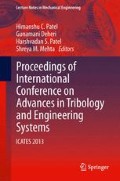Abstract
Modern lubricants are careful balance of mineral or synthetic base stock, coupled with oil additives to enhance an existing property of the based oil such as oxidation resistance. In used oil analysis, nonconforming test data related to lubricant physical and chemical properties; contamination and wear debris is frequently encountered. The paper presents shear stability and extreme pressure test in order to characterize base stock oil and effect of blend low viscosity oil in the based oil. In present analysis, the oil used in sewing machine for the purpose of lubrication is used as blend oil in the Castrol GTX oil. The ASTM performance tests were conducted on the four ball test rig for comparative study which establishes the way that the mechanical solicitations during service life of the oils affect the viscosity modification and thus the quality of the oil performance.
Access this chapter
Tax calculation will be finalised at checkout
Purchases are for personal use only
References
Abdel-Azim A et al (2001) Polymeric Additives for improving the flow properties and viscosity index of lubricating oils. J Polym Res 8:111–118
Yorulmaz Y (1983) Alkylated polymers as lube oil additives. J Mater Sci 18:1638–1640
Boerlage GD (1933) Four-ball testing apparatus for extreme pressure lubricants. Engineering, 1 CXXXVI(3522):46
Ripa M, Spanu C et al, (2008) Characterization of hydraulic oils by shear stability and extreme pressure tests tribology in industry, 30(3&4)
Troyer DD (1999) The sequential four ball test. Practicing Oil Analysis Magazine, November 1999
Perez J et al (1999) Sequential four-ball study of some lubricating oils. Lubrication Engineering, Sept 1999, pp 28–30
ASTM D4172-94 (2010) Standard test method for wear preventive characteristics of lubricating fluid (four-ball method) Developed by subcommittee: D02.L0.11 Book 07 stemdends volume: 05.02
Majumdar BC (1999) Introduction to tribology of bearings. Wheeler Publishing, New Delhi
Bhushan B (1999) Principles and applications of tribology. Wiley, New York
Author information
Authors and Affiliations
Corresponding author
Editor information
Editors and Affiliations
Rights and permissions
Copyright information
© 2014 Springer India
About this paper
Cite this paper
Sutaria, B.M., Bhatt, M.K., Sonigra, B.K., Bhatt, D.V. (2014). Study on the Effect of Blend Oil with Based Oil Analysis. In: Patel, H., Deheri, G., Patel, H., Mehta, S. (eds) Proceedings of International Conference on Advances in Tribology and Engineering Systems. Lecture Notes in Mechanical Engineering. Springer, New Delhi. https://doi.org/10.1007/978-81-322-1656-8_22
Download citation
DOI: https://doi.org/10.1007/978-81-322-1656-8_22
Published:
Publisher Name: Springer, New Delhi
Print ISBN: 978-81-322-1655-1
Online ISBN: 978-81-322-1656-8
eBook Packages: EngineeringEngineering (R0)

